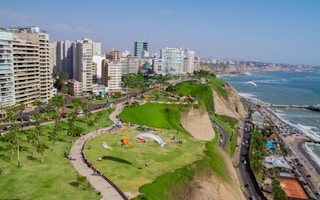For the past week in Bonn, Germany, climate negotiators have tackled many of the core issues that are key to reaching a new international climate agreement in 2015. While the pace was slow at times, the discussions were thorough and constructive, building on the positive energy from the recent UN climate summit in New York.
To continue reading, subscribe to Eco‑Business.
There's something for everyone. We offer a range of subscription plans.
- Access our stories and receive our Insights Weekly newsletter with the free EB Member plan.
- Unlock unlimited access to our content and archive with EB Circle.
- Publish your content with EB Premium.
Many questions came into sharper focus, as did the central tasks for the next major moment in the UN Framework Convention on Climate Change (UNFCCC) talks—COP 20 in Lima, Peru in December. As this Bonn session concludes, here are some takeaways on what needs to happen in Lima to set the stage for an ambitious, effective global climate agreement:
-
Transparency in the “INDCs”: Countries will submit their post-2020 domestic climate action plans—their “intended nationally determined contributions” (INDCs)—in the early part of 2015, with major emitters expected to do so by the end of March. In Lima, countries will need to agree on what “up-front information” they’ll include in these contributions. Information about post-2020 targets and actions is essential—for example, in what sectors a country will reduce its emissions. A major question is the end-date for these post-2020 action plans. To ensure INDCs can be compared effectively, countries will need to agree to a common end date, such as 2025.
-
Assessing the INDCs: At the moment, countries have not yet decided on a way to review each other’s contributions. Assessing the INDCs will be vital to evaluating whether they collectively meet the goal of limiting global temperature rise to 2 degrees C, thus preventing some of the most disastrous impacts of climate change. This assessment should provide a context for countries to reconsider their offers if they’re not ambitious enough. Countries should also make sure that the assessment process leads to real engagement about the contributions before Paris, including through a UNFCCC secretariat synthesis report on how mitigation contributions add up in relation to the 2 degree goal and an electronic bulletin board with countries’ INDCs that allows comments by civil society and responses from governments.
-
“
Countries need to decide on incorporating “cycles” of action, which would be agreed to at regular intervals after 2015. These cycles could address mitigation commitments, adaptation and finance in a way that enables them to build on each other. Doing this will make the agreement long-lasting and help ensure that countries have a plan in place to ramp-up their action over time.
Framing an agreement for the future: To get fully on the pathway to Paris, where the new agreement will be concluded in 2015, countries will need to agree at Lima on a clear framework and set of elements for the agreement. In Lima, countries should not only establish the core components of the 2015 agreement, but also the longer-term process for climate action under the UNFCCC. Countries need to decide on incorporating “cycles” of action, which would be agreed to at regular intervals after 2015. These cycles could address mitigation commitments, adaptation and finance in a way that enables them to build on each other. Doing this will make the agreement long-lasting and help ensure that countries have a plan in place to ramp-up their action over time. In addition, many countries have suggested that a long-term emissions goal such as phasing-out greenhouse gases should be included in the 2015 agreement in order to set the direction for future action.
-
Adaptation: Like the last negotiations in Bonn in June, many countries raised adaptation as a central issue for the 2015 agreement. Countries will need to decide at Lima on whether to include adaptation in national contributions. Meanwhile, support seems to be building for the inclusion of a global adaptation goal in the main 2015 agreement.
-
Finance: The Lima COP will need to increased clarity on the role of finance in the 2015 agreement. A key factor in these discussions will be the result of the “pledging” conference for the Green Climate Fund (GCF), to be held in late November. The GCF is expected to become the most important vehicle for securing and distributing climate finance, with developed nations expected to contribute $10 billion by the end of this year. Already more than $2.5 billion has been pledged, including Sweden’s pledge of $550 million this week, but substantial additional resources are needed. The GCF funding sets a foundation for finance in the 2015 agreement, which will also need to create a roadmap for mobilizing $100 billion a year in climate finance by 2020, as well as for post-2020 finance.
-
Pre-2020 action: While the 2015 agreement will focus on post-2020 climate action, countries also have an opportunity in Lima to move forward on pre-2020 action. At recent negotiations in Bonn, a series of Technical Expert Meetings on key mitigation opportunities showcased how possible it is for countries to shift to low-carbon economies. Countries can take the next step by deciding how to actually implement those opportunities and create more ambitious short-term climate action plans.
Moving forward after Bonn
One key event outside the negotiating halls pointed strongly in the right direction. This past week, the European Union heads of state adopted a new climate policy to reduce emissions by at least 40 percent below 1990 levels by 2030, setting the floor for its mitigation action and leaving the door open to go even further.
That decision in Europe should be the starting bell on the way to Lima and the 2015 agreement. Now it’s up to all countries to move the negotiations into high gear.
David Waskow is director, World Resources Institute’s (WRI) International Climate Initiative. This post is republished from the WRI Insights blog.











